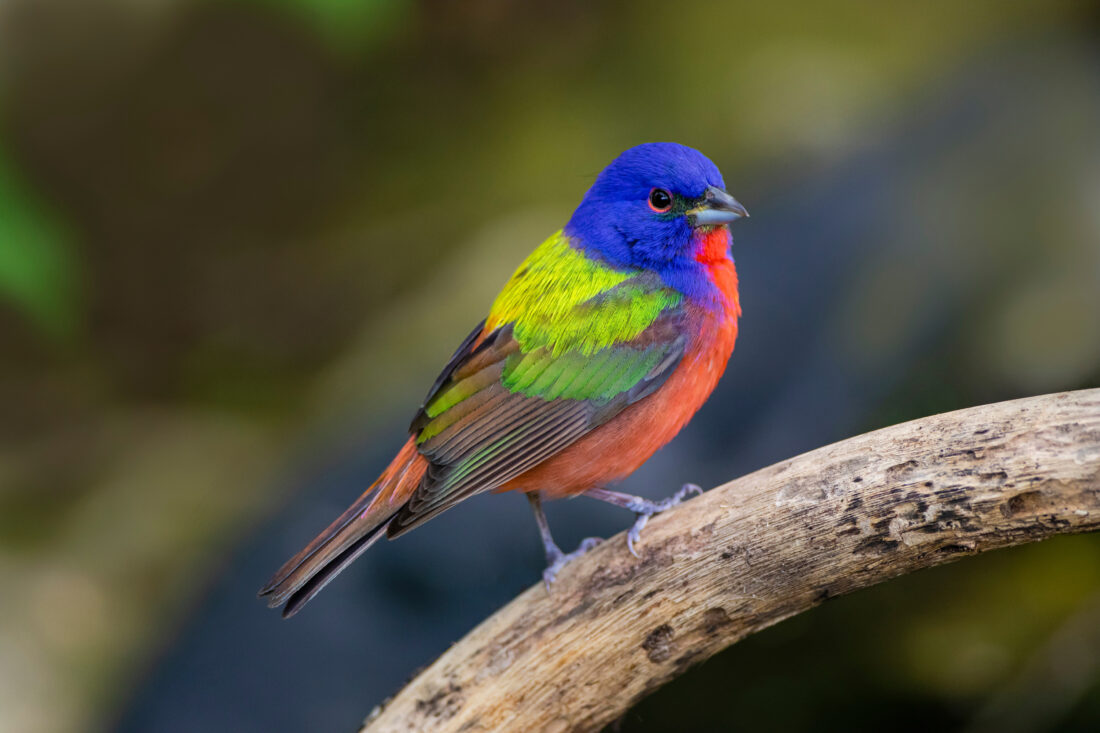Unmatched in their range of rippling colors, shapes, and sizes, birds are the most diverse and beautiful group of land-based vertebrates on the planet. Bird feathers are made of keratin, the same protein responsible for hair, nails, beaks, horns, and scales, and they take their color from either pigments or from light refraction caused by the feather’s structure. Couple that fascinating—and endless—potential for color combinations with sexual selection, whereby females choose ever-brighter males as mates, and we end up with everything from the outlandish tail of a male peacock to the iridescence of a tiny hummingbird’s throat.

Here in the southern U.S., there’s no shortage of stunning birds. Below, we rounded up seven of the most striking avians that either live in the South year-round or grace its habitats for part of the year.
Roseate spoonbill
In some ways these wading birds are ungainly: They sport long spindly legs and wide, flat bills that allow them to forage in the shallow waters and mud flats of coastal Florida, Texas, and southwestern Louisiana, where they most commonly make their homes. But spot their ombre-pink feathers in flight or popping against green marsh grass, and you won’t forget the sight. Like flamingos, roseate spoonbills get their pink coloring from their diet, which includes carotenoid-rich crustaceans and aquatic invertebrates. Though they have been known to pop up along the coasts of the Carolinas and Georgia (and even New York), your best chance to spot them is in Everglades National Park—they frequent Paurotis Pond in winter and Eco Pond in summer.
Green jay
Spotting a green jay will require a trip to South Texas, the northernmost part of their range, where they live in family flocks that nest in thorny bushes and travel around feeding on anything from arthropods to fruit. But it’s worth it to witness that unmistakable cobalt-blue head and bright green body—an example of something called structural color. (Barbs on the feather scatter short wavelengths of light, creating greens and blues.) Like other jays, they’re imitators, often copying the call of local hawks to ward off competitors to a food source. To see one, visit the Laguna Atascosa or the Santa Ana National Wildlife Refuges.
Painted bunting
Male painted buntings are so brilliantly colored they look more like a painting than a bird; indeed, they are sometimes called the “nonpareil,” French for “unrivaled.” All of the avenues toward color converge in this little songbird: Carotenoids from food lend the red breast, melanin creates the tinge of browns, structural color results in the blues, and the pigment porphyrin contributes to the greens. Painted buntings frequent brushy areas, woodland edges, and marshes all over the Southeast, though many migrate to Florida and the northern Caribbean for the winter. Tempt them to your backyard bird feeder with smaller seeds like white proso millet or sunflower hearts or chips.
Prothonotary warblers
Birders are always eager to spy this cheery warbler, which takes its sunny color from its diet of insects and its name from the yellow robes once worn by papal clerks (named prothonotaries) in the Roman Catholic Church. Come spring, the warblers arrive in the Southeast from wintering grounds along the coast of Mexico and Central and South America, ready to nest in tree cavities (they’re one of only two warblers that do so). They’ll also settle into a nest box—learn how to set one up here.
Wood duck
Don’t let the drab name fool you: The wood duck is one of the most colorful aquatic bird species on the continent. Pigments lay the base for a kaleidoscope of black, brown, red, yellow, green, and violet, and the feather structure lends a final sweep of blueish iridescence by refracting light. In addition to its beauty, the wood duck also represents a conservation success story. It was almost wiped out by years of hunting and habitat loss, but recovery efforts—including nesting box installation, habitat protection, and hunting regulations—have allowed it to make a comeback. Now, wood ducks are a year-round Southern resident of ponds, wooded swamps, bottomlands, and marshes.
Scissor-tailed flycatcher
The state bird of Oklahoma stands out as much for its shape as for its orange-splashed sides; a long, deeply forked white tail trails the slender body. This insect-eating bird loves open grasslands dotted with trees and shrubs, but it also does well in urban areas. Its range spans the Midwest, Oklahoma, Texas, and down into Central and South America, though small numbers will winter in Florida. They won’t visit a feeder, so your best bet for attracting them is creating a bug-rich habitat packed with grasshoppers, moths, caterpillars, and beetles.
Pileated woodpecker
The woodpecker family comes in all shapes and sizes, all sporting some striking combination of red, black, and white. White coloration in birds is structural just like blue, but like all other white objects, a white feather fully reflects and scatters all wavelengths of light. The pileated woodpecker’s wingspan stretches well over two feet, and a fiery red crest crowns its head. (Males have a red cheek stripe to match.) They’re common throughout the eastern United States and favor cypress swamps or mature forests with large trees. A distinctive high, piping call betrays their presence, and they just might make a feeder appearance if you put out suet in a large, upright feeder.








